Why are Iranians crossing the Channel in dinghies?
More than 100 migrants, claiming to be Iranian, have attempted the dangerous journey by small boat to the UK in the past three weeks. Why?
On 23 November, shortly before sunrise, eight migrants were found clinging to a dinghy in choppy waters off the coast of Kent.
They told their rescuers they had spent 12 hours at sea.
It was a similar story the day before, when seven more were found in a boat just off the Dover coast - the same number of people had been pulled from an inflatable boat just a few hours earlier.
Since 3 November, 101 migrants - including four children - have attempted the 21-mile journey across the Channel, one which police have likened to "trying to cross the M25 at rush-hour on foot".
 Gareth Fuller/PA
Gareth Fuller/PAThe Home Office has refused to publish official figures, but the BBC has established that at least that number have entered British shores since the start of the month.
Without fail, the migrants have told officials they are Iranian.
British and French authorities, under pressure to stem the rise in boat trips before a life is lost, face several questions.
Why have so many boats set off for the coast of Kent? What can be done to stop it? And why are all the occupants apparently from the Middle Eastern country?
The answer to the last question could lie 1,200 miles away in the Serbian capital of Belgrade.
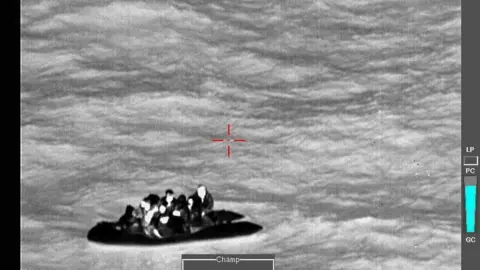 Premar Manche
Premar MancheMiodrag Ćakić, chief executive of Refugee Aid Serbia, which monitors migration through the Balkans, believes migrants arriving in the UK are among the thousands who flew into Serbia after the country began offering visa-free access to Iranians in August last year.
The move was ostensibly intended to increase tourism and trade between Iran, the world's 25th largest economy, and Serbia, the 90th.
The visa scheme - which attracted allegations it was being abused by migrants seeking access to western Europe - ended on 17 October, by which time some 40,000 Iranians were said to have flown to the Balkan nation.
It is unknown how many returned home, but according to the Associated Press, local media reported that direct flights from Tehran to Belgrade had been arriving full and returning empty.
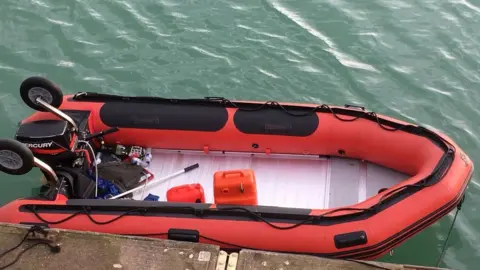
According to Info Park, a refugee support centre in Belgrade, Serbian police estimate the number of Iranians who failed to return at 12,000.
Mr Ćakić said it was believed within the refugee community that Iranians were using "false passports and more complex methods" to enter western Europe.
They arrived better prepared for the journey ahead and would stay in hostels or hotels.
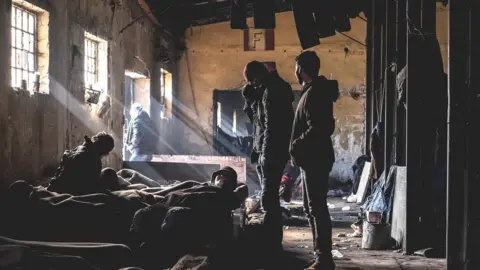 Miodrag Ćakić/Refugee Aid Serbia
Miodrag Ćakić/Refugee Aid SerbiaMeanwhile, refugees from countries such as Syria, Iraq, Afghanistan and Pakistan, travelled thousands of kilometres on foot and ended up living on the streets or in derelict buildings across Belgrade.
Compared to fellow migrants, the Iranians looked "more like tourists... they were kids in hoodies and jeans, with backpacks", said Gordan Paunovic, of Info Park.
"Many of [the Iranians] were travelling with fake passports, which were costing between 3,000 to 6,000 euros in Istanbul.
"They didn't share the normal fate of refugees and migrants who have a very hard time in the Balkans. They would not be forced to sleep rough or go to refugee centres like the other people.
"They were here for a month, staying in hotels, and would find a smuggler to make other arrangements."
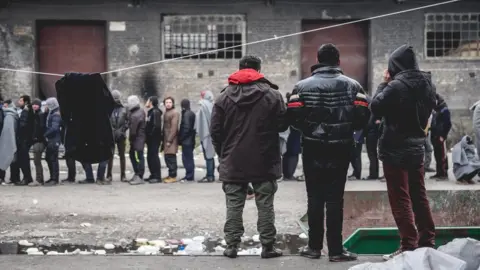 Miodrag Ćakić/Refugee Aid Serbia
Miodrag Ćakić/Refugee Aid SerbiaIranians may be set apart from fellow migrants by their economic prosperity, yet for many living under the repressive regime, life is far from easy.
Kaveh Kalantri, of the Iranian Association, which supports refugees in the UK, said a lack of freedom and human rights violations were driving some Iranians out.
"People get arrested if they have liberal or left-wing views, or if they are from religious minorities. A lot of people experience violence on a daily basis."
Since the Islamic Revolution in 1979, it has been estimated that between 150,000 and 200,000 Iranians have left the country every year.
In the past two years, Iranian citizens have made more UK asylum applications than any other nationality, according to Home Office figures. In 2017, they accounted for 9% of the 26,350 applications.
"Iranians coming to the UK is not unusual, but the way they are coming is," Mr Kalantri said.
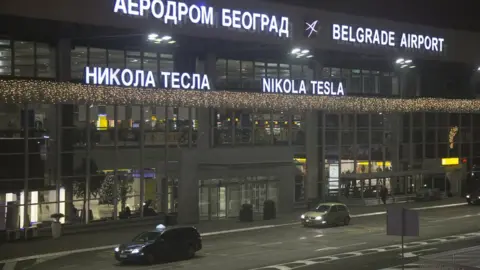 Nicolas Economou/NurPhoto/Getty Images
Nicolas Economou/NurPhoto/Getty ImagesOne theory as to why Iranians are choosing to risk their lives on boats stems from their comparative wealth - simply put, they can afford to pay smuggling gangs to get them onboard a vessel.
Maya Konforti, of L'Auberge des Migrants, a refugee support group in Calais, described the attempted crossings as "the speciality of Iranians".
"Crossing by boat can only be done by people who have some money. Africans don't have any left by the time they arrive in Calais," she said.
"There is a new influx of Iranians arriving in Calais. They seem to be the only ones who both dare to do it and find the means to do so."
 Jeremias Gonzalez/IP3
Jeremias Gonzalez/IP3Mr Ćakić suggested Iranians heading for Kent had entered the EU via Serbia.
"I don't see any other explanation. Serbia was the only country on the Balkan Route that had a significant number of Iranians."
Not everyone believes all the migrants are Iranian. Prof Adib-Moghaddam, from the Centre for Iranian Studies at SOAS University of London, suspects most of them are of Afghan origin.
However, immigration specialist Emma Nawaz said she "could not see what benefit they would achieve by falsely saying that they are Iranian".
You might also be interested in:
Regardless, the "surge" in attempts is being fuelled by "organised criminal and mafia networks" in France, according to Ingrid Parrot, who works for the Maritime prefecture - the Border Force equivalent based in Cherbourg.
She said there had been 30 attempted crossings in 2018, 12 in 2017, and 23 the year before.
The majority failed because the vessels were too small - mostly canoes, dinghies and "makeshift" boats - but several attempts in 2018 have been made in pleasure crafts and speedboats, which have seen a spike in thefts.
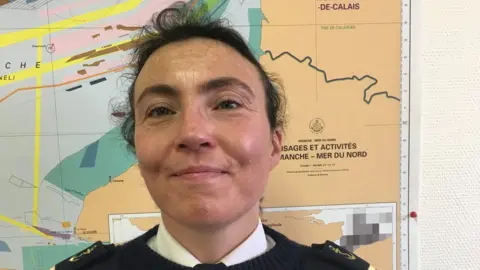 Premar Manche
Premar MancheBorder Force officers have reported that "access to small craft was getting easier and cheaper, creating more opportunities for criminals to involve themselves in the facilitation of clandestine entry and smuggling," according to an inspection of the South Coast ports, published this month.
But understanding the true scale of the issue is complicated by the department's insistence that revealing the number of so-called "clandestine entries" made by boat would "prejudice the operation of immigration controls".
Dover and Deal MP Charlie Elphicke, who described the rise in boat crossings as "unprecedented", said Border Force needed more resources, including investment in additional patrol boats to act as a deterrent.
He said the number of migrants detected in lorries in Dover had "plummeted" by more than a third since the Calais Jungle was dismantled.
But Bridget Chapman, of Kent Refugee Action Network, said the increase in boat crossings was a "natural consequence of the hostile environment and tightening up the borders".
"People are having to find ways that are more and more dangerous," she added.
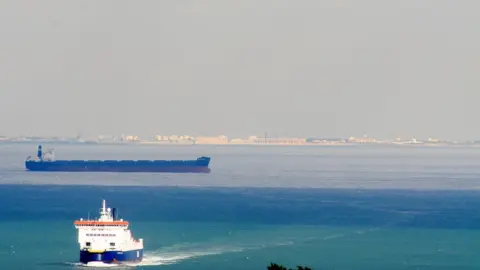 Barcroft Media/Getty
Barcroft Media/GettyAshford MP and former immigration minister Damian Green said emphasis should be placed on "actually knowing where people are coming from [and] breaking up the international criminal gangs that are actually behind this".
"If we do need more resources, that's where they should go," he added.
The Home Office said officials were focusing on "identifying and dismantling the organised crime groups that facilitate illegal immigration".
Ms Parrot said the French were already "strengthening measures" to prevent attempted crossings, rather than focusing only on launching rescue operations.
"Our greatest fear is, on the one hand, a collision that leads to a loss of human life and, what's more, an accident at sea that we need to assist with," she said.
"On the other hand, our other fear is having injured people at sea and bodies on the beaches. We do not want it to come to that."
A note on terminology: The BBC uses the term migrant to refer to all people on the move who have yet to complete the legal process of claiming asylum. This group includes people fleeing war-torn countries, who are likely to be granted refugee status, as well as people who are seeking jobs and better lives, who governments are likely to rule are economic migrants.
